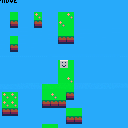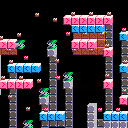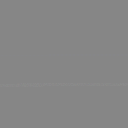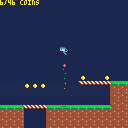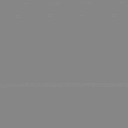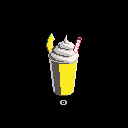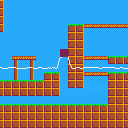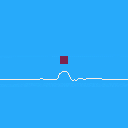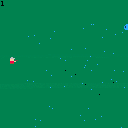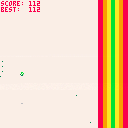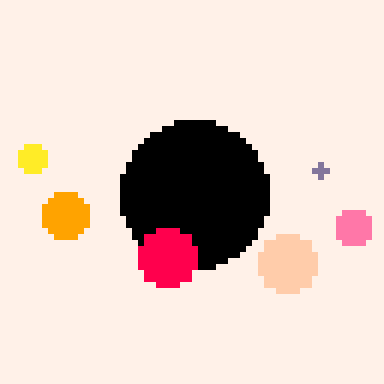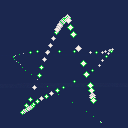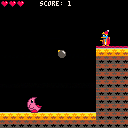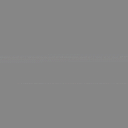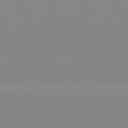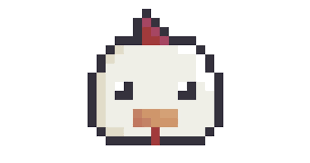Please read all of this. It'll only take a minute and it'll teach you how to use this cart.
The ultimate cake factory!
Build your own production line! You can use conveyor belts, springs, antigravity zones, and more!
How to get started:
open the cart file in your pico-8 editor. (Sadly, an in-game editor has not yet been implemented in this version). Go to the map editor! To summon cakes, place a green dispenser. To move the cakes, use various tools to build a path, such as conveyor belts, springs, and antigravity zones. Once a cake finishes its journey, the only way to delete it is to drop it out of the world.
THINGS TO NOTE:
-To turn off the 3D map, change MAP_3D in the _INIT() function to FALSE.


Currently I'm trying to learn tline() by simply drawing the map. However, I have no idea how the parameters work. Apparently, according to the pico 8 wiki, tline()'s 5th and 6th parameters are expressed in "fractional map tiles" but I don't get what that means...
Can someone give a brief explanation?

I'm working on a farming simulator game. In the _init() function it should randomly generate the pattern on the grass tile and then randomly place the grass tile on the map (replacing any empty tiles.) However, a strange bug is occurring where some map tiles are corrupt. Can somebody explain what's going on? Use arrow keys to move around.
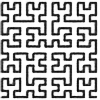

This is a proof of concept! It's a platformer where you use buoyancy to gain altitude. The deeper you dive, the more altitude you gain when popping out of the water! Kinda like a floatie in the pool.
Use left and right to move. Press X to dive deeper (when submerged) and O to move upwards (also while submerged). On land, press O to jump. Try to collect all the gems.


The idea: a platformer where you use buoyancy to gain altitude.
Controls: Left and right to move. Up lets you swim upwards (while submerged) and down lets you swim downwards (while submerged.)
Play around with the water physics!
PS if you can help me code map collision (which I suck at) it would be greatly appreciated!



function _init()
poke(0x5f2d,1)
mx,my=stat(32),stat(33)
cursor_x,cursor_y=64,64
nodes={}
constant={n="constant",x=0,y=0,c=8}
counter={n="counter",x=0,y=0,c=3}
cam_x,cam_y=-60,-63
end
function _update60()
if (btnp(🅾️)) new(constant)
if (btn(⬆️)) cam_y-=1
if (btn(⬇️)) cam_y+=1
if (btn(➡️)) cam_x+=1
if (btn(⬅️)) cam_x-=1
end
function new(n)
add(nodes,n)
n.x=cursor_x+cam_x
n.y=cursor_y+cam_y
end
function _draw()
chosen = nil
cls(0)
for i, node in ipairs(nodes) do
print(node.n .. " " .. node.x .. " " .. node.y, 0, i * 6, node.c)
rect(node.x - cam_x, node.y - cam_y, node.x + 8 - cam_x, node.y + 4 - cam_y, node.c)
if stat(34) ~= 0 and
cursor_x >= node.x - cam_x and
cursor_x <= node.x + 8 - cam_x and
cursor_y >= node.y - cam_y and
cursor_y <= node.y + 4 - cam_y then
chosen = node
end
end
if stat(32) ~= mx or stat(33) ~= my then
cursor_x = stat(32)
cursor_y = stat(33)
end
if chosen ~= nil then
print(chosen.x, 0, 0, 12)
chosen.x = cursor_x + cam_x - 4
chosen.y = cursor_y + cam_y - 2
end
pset(cursor_x + 1, cursor_y, 6)
pset(cursor_x, cursor_y + 1, 6)
pset(cursor_x - 1, cursor_y, 6)
pset(cursor_x, cursor_y - 1, 6)
end |
The goal: when you create a new node object, it should be at the cursor's position. You can drag them around. Press the circle button to create a new node. Use the arrow keys to move the camera. Use the mouse to drag nodes.
The problem: whenever a node is created or clicked, every single existing node's position moves to the mouse.
I'm sure it's some small detail I'm missing but I just can't find it. I would be very thankful for your help










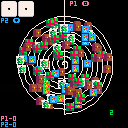
 0 comments
0 comments
